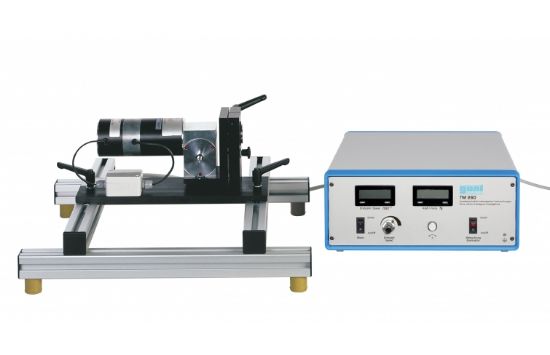Tribology studies friction, wear and lubrication. Friction occurs when two solids are in contact with each other and their movement is impeded. If material is lost progressively during this process, it is referred to as wear. Lubricants are used to minimise friction and wear.
The TM 260 drive unit, together with the experimental units TM 260.01 to TM 260.06, offer a complete course with a series of experiments to study tribological phenomena. Various rolling and sliding cases can be demonstrated in the classroom or studied in the laboratory. The parameters of a tribological system are recorded and analysed. A comprehensive range of friction pairings makes it possible, among other things, to represent how the frictional force is independent of the contact area.
The TM 260 units comprise a frame on which the drive unit is mounted together with an experimental unit and a display and control unit. Quick-action chucks make it quick and easy to assemble. The drive unit has a pivotable motor block bearing. This allows the drive shaft to be installed horizontally or vertically. The speed of the DC motor is continuously adjustable and is detected by means of an incremental encoder. The frictional forces are measured by a force sensor in each experimental unit.
The display and control unit shows frictional force and speed, the latter of which can be adjusted continuously.
The following experiments can be conducted: Rolling friction in friction wheels (TM 260.01), Elasto-hydrodynamic behaviour (TM 260.02), Dynamic friction in a pin on a disk (TM 260.03), Frictional vibrations (TM 260.04), Dynamic friction in a cylindrical pin on a roller (TM 260.05), Pressure distribution in journal bearings (TM 260.06).

Drive unit for tribological investigations
Tribology studies friction, wear and lubrication. Friction occurs when two solids are in contact with each other and their movement is impeded. If material is lost progressively during this process, it is referred to as wear. Lubricants are used to minimise friction and wear.
The TM 260 drive unit, together with the experimental units TM 260.01 to TM 260.06, offer a complete course with a series of experiments to study tribological phenomena. Various rolling and sliding cases can be demonstrated in the classroom or studied in the laboratory. The parameters of a tribological system are recorded and analysed. A comprehensive range of friction pairings makes it possible, among other things, to represent how the frictional force is independent of the contact area.
The TM 260 units comprise a frame on which the drive unit is mounted together with an experimental unit and a display and control unit. Quick-action chucks make it quick and easy to assemble. The drive unit has a pivotable motor block bearing. This allows the drive shaft to be installed horizontally or vertically. The speed of the DC motor is continuously adjustable and is detected by means of an incremental encoder. The frictional forces are measured by a force sensor in each experimental unit.
The display and control unit shows frictional force and speed, the latter of which can be adjusted continuously.
The following experiments can be conducted: Rolling friction in friction wheels (TM 260.01), Elasto-hydrodynamic behaviour (TM 260.02), Dynamic friction in a pin on a disk (TM 260.03), Frictional vibrations (TM 260.04), Dynamic friction in a cylindrical pin on a roller (TM 260.05), Pressure distribution in journal bearings (TM 260.06).
